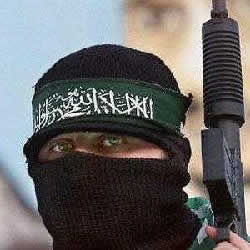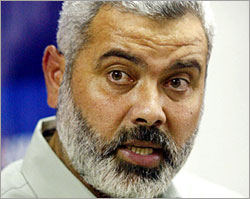This month, Qatar
...an emirate on the east coast of the Arabian Peninsula. It sits on some really productive gas and oil deposits, which produces the highest per capita income in the world. They piss it all away on religion, financing the Moslem Brotherhood and several al-Qaeda affiliates. Home of nutbag holy manYusuf al-Qaradawi...
announced the suspension of its mediation role between Israel and Hamas
 ..not a terrorist organization, even though it kidnaps people, holds hostages, and tries to negotiate by executing them,...
..not a terrorist organization, even though it kidnaps people, holds hostages, and tries to negotiate by executing them,...concerning a potential Gazoo ceasefire and hostage release. At the same time, Doha refrained from confirming whether it would close Hamas’s office in the country, despite requests from the Biden administration to do so.
Qatar has hosted Hamas officials in Doha since 2012, when the terror group moved its headquarters out of Damascus amid the Syrian civil war; Washington had urged Qatar to serve as a conduit to the terror group, much as the Gulf state had done by hosting a Taliban
...mindless ferocity in a turban...
embassy.
Even if the group were expelled from Qatar, it’s not clear who the order would apply to, with Hamas’s leadership structure made suddenly opaque by the killings of its last two chiefs Ismail Haniyeh
...became Prime Minister of Gaza after the legislative elections of 2006 which Hamas won. President Mahmoud Abbas dismissed Haniyeh from office on 14 June 2007 at the height of the Fatah-Hamas festivities, but Haniyeh did not acknowledge the decree and continues as the PM of Gazoo while Abbas maintains a separate PM in the West Bank...
and Yahya Sinwar in recent months.
Following the losses, the terror group has reportedly opted against appointing an immediate successor. Instead, a five-member committee based in Doha is said to have taken over leadership responsibilities.
According to Hamas sources speaking to AFP, the committee was set up in August following the liquidation of Haniyeh in Tehran. While Sinwar was named head of the group, the fact that he was in hiding in Gaza made communication difficult, necessitating an alternative. When Israeli forces killed Sinwar on October 16, the quinquevirate stepped in.
The collective leadership structure could be a defensive strategy for Hamas, nominating five heads rather than a single chief who would immediately be in Israel’s crosshairs.
But the group also appears to want to present Paleostinians with an "inclusive" leadership committee, one that spans Gaza and the West Bank and includes both political and religious figures, as it navigates a period of profound crisis for its future.
"This appears to be mostly a symbolic decision to indicate that all components of Hamas are represented," said Hamas expert Guy Aviad, a former official in the IDF’s History Department, which maintains the military’s official annals.
"Joint leadership is not necessarily aimed at preventing assassinations. If Israel wanted to eliminate a number of leaders, it could do so," Aviad told The Times of Israel, adding that Israel is unlikely to conduct liquidations within Qatar or
...the occupiers of Greek Asia Minor...
The current governance structure will be in place until the terror group holds elections for a new leader, which are scheduled for March next year, according to AFP.
There is also speculation that Hamas may have already secretly appointed a new leader but is concealing his identity, a tactic used in 2004 after the assassinations of leaders Sheikh Ahmed Yassin and Abdel Aziz Rantisi within months of each other. A Hamas source told the BBC in October that the movement is likely to keep the identity of its new leader secret for security reasons.
PARTY OF FIVE
According to Hamas sources who spoke to AFP, the committee is composed of five politburo members:
- Khalil al-Hayya: Previously Sinwar’s deputy, he currently acts as the liaison between Hamas in Gaza and abroad. He relocated to Qatar from Gaza shortly before the October 7 attack and is seen as a probable candidate to lead the organization in the future, chiefly because of his proximity to the Iranian regime.
- Khaled Mashaal: Head of the foreign politburo abroad, he is the most well-known and experienced Hamas official alive, having led the politburo for 22 years between 1996 and 2017. Despite his credentials, he is not touted as a potential future leader — Yahya Sinwar himself reportedly rejected his candidacy. Mashaal has strained relations with Tehran, dating back to when he turned against Syrian President Bashar Assad, a close Iran ally, during the Syrian civil war. After Hamas was booted from Syria, Mashaal became persona non grata in Tehran as well, while most of the group’s politburo increasingly gravitated toward the Iranian regime. In early October, he met with Iranian President Masoud Pezeshkian in Doha, where he currently resides, indicating a possible rapprochement.
- Zaher Jabarin: In charge of Hamas in the West Bank since January, he lives in Istanbul and supervises the terror group’s finance department. Jabarin is believed to be behind attempts to revive Hamas’s strategy of suicide bombings against Israeli civilians in recent months. Israeli security officials indicated that an attempted suicide bombing in Tel Aviv in August had been overseen by Hamas in Turkey, suggesting Jabarin’s direct involvement in the plot.
- Muhammad Ismail Darwish: Darwish heads Hamas’s Shura Council, a religious advisory body composed of about 50 clerics. Darwish was an unknown figure until reports in the Arab media in August claimed that he would succeed Haniyeh as the head of the terror group, though Sinwar got the nod in the end. Very little is known about him other than he lives in Qatar.
- An unnamed fifth official: The identity of the fifth committee member is unknown, but it can be presumed that the group would appoint at least one member who is still inside the Gaza Strip. Michael Milshtein, head of the Palestinian Studies Forum at the Moshe Dayan Center at Tel Aviv University, told The Times of Israel that an anonymous source close to Hamas named the figure as Nizar Awadullah, a politburo member who was a runner up to Sinwar in internal elections in 2021. Awadullah is thought to still be living in the Strip.
Notably absent from the list is Yahya Sinwar’s brother Muhammad, considered to be the de facto commander-in-chief of military operations in Gaza, where he is believed to be. (Israel says it killed titular armed wing head Mohammed Deif.)
According to experts, Muhammad Sinwar is not a political figure, making him an unlikely choice for the leadership council. Nonetheless, he still wields sizable influence within Hamas thanks to his control of Hamas’s forces in Gaza and of the Israeli hostages.
STAYING THE COURSE
The ability of the leadership quintet to influence actions within Gaza remains uncertain due to ongoing communications difficulties between the Strip and the rest of the world. The IDF’s monitoring of mobile communications complicates Hamas’s coordination, leading the group to rely on encryption technology or hard-to-come-by satellite phones.
Despite the difficulties in communication, it appears that for the time being the new leadership has not enacted any major shifts in its strategy, whether on the military front or in negotiations for a ceasefire deal.
On the battlefield, experts expect the group to continue fighting a war of attrition against the Israeli military until there is an agreement that meets its conditions: an open-ended halt to hostilities, a full withdrawal of IDF troops from the Gaza Strip, the release of Palestinian detainees in return for hostages, and guarantees that it will not be wiped out after the hostages are freed.
Until those demands are met, the group is expected to keep conducting guerrilla operations with what forces it has left, while hanging onto the hostages both as a bargaining chip and a cudgel, “deepening the wound inside Israeli society” and the fracture between citizens and their political leaders, Aviad said.
“Hamas will not change its principles and will not accept a deal that diverges from its conditions,” he said. “Right now, it is in a win-win situation: if it gets its way in negotiations, all the better. If not, it will keep embittering the lives of Israelis, to hold the hostages captive and spill the blood of soldiers and reservists.”
The only area where the joint leadership might show some flexibility is in the details of a ceasefire deal, Milshtein said.
To advance negotiations, it might agree to a staged IDF pullout, with some troops remaining after some hostages were released, but the leadership committee won’t back off the demand for all IDF troops to leave Gaza by a final stage, the expert said. Under Sinwar, the terror group had already shown some flexibility on the timing of the IDF withdrawal.
A PARTIAL BREAKUP WITH HAMAS
Experts concur that the expulsion of Hamas leaders from Qatar currently seems unlikely – similar rumors have circulated before.
The Gulf petrostate has temporarily pulled back its involvement on a Gaza ceasefire and hostage deal, but it benefits greatly from its role mediating between the US and groups Washington finds too odious to engage with directly. Doha is unlikely to risk surrendering that prestigious position, and will probably resume its mediating role on Gaza at some point in the future, Aviad said.
However, things might change under President-elect Donald Trump, whose administration may seek to flex its muscles in the Middle East.
Qatar’s recent suspension of mediation could signal its nervousness about Trump, Milshtein suggested, particularly recalling the country’s isolation during the 2017-2021 boycott by Saudi Arabia and four other Arab states.
It may also be a tactic to put pressure on Hamas and demand more flexibility while the getting is good.
“Doha knows that once Trump becomes president, it will be much tougher for them to mediate between the parties,” Milshtein said, referring to the pro-Israel slant that the Trump administration is expected to follow.
However, it will take “enormous pressure” for Qatar to ultimately expel Hamas, Milshtein said. For instance, the Pentagon could threaten to pull out of Qatar’s al-Udeid air base, the largest US military installation in the Middle East.
International pressure of this type has worked in the past. The Saudi-led boycott is considered to be the catalyst for Qatar’s expulsion of senior Hamas leader Saleh al-Arouri in 2017. Al-Arouri was assassinated in an Israeli airstrike in Beirut at the beginning of the year.
“The Qataris know how to be more flexible and take steps when they are under pressure,” Milshtein said. “But I don’t think right now that pressure is enough.”
Related:
Khalil al-Hayya 11/05/2024 Hamas, Fatah said to agree to set up technocratic administration for postwar Gaza governance
Khalil al-Hayya 10/27/2024 Hamas leaders rejected Israeli offer of safe passage if they freed hostages — report
Khalil al-Hayya 10/22/2024 Hamas sources say Doha-based committee to head terror group after Sinwar killed
Khalil al-Hayya 11/05/2024 Hamas, Fatah said to agree to set up technocratic administration for postwar Gaza governance
Khalil al-Hayya 10/27/2024 Hamas leaders rejected Israeli offer of safe passage if they freed hostages — report
Khalil al-Hayya 10/22/2024 Hamas sources say Doha-based committee to head terror group after Sinwar killed
Related:
Khaled Mashaal 10/19/2024 Who’s next? Speculation swirls on who will take over Hamas from slain Sinwar
Khaled Mashaal 10/10/2024 ‘Megalomaniac’ Sinwar ordered renewal of suicide bombings after taking power – report
Khaled Mashaal 10/09/2024 Oct. 7 Anniversary: Hamas Leader Wants ‘New Fronts’ of Jihad
Khaled Mashaal 10/19/2024 Who’s next? Speculation swirls on who will take over Hamas from slain Sinwar
Khaled Mashaal 10/10/2024 ‘Megalomaniac’ Sinwar ordered renewal of suicide bombings after taking power – report
Khaled Mashaal 10/09/2024 Oct. 7 Anniversary: Hamas Leader Wants ‘New Fronts’ of Jihad
Related:
Zaher Jabarin 10/22/2024 Hamas sources say Doha-based committee to head terror group after Sinwar killed
Zaher Jabarin 09/22/2024 Little-known Hamas leader seen behind resurgence of West Bank suicide bombings
Zaher Jabarin 05/11/2022 Israel said prepping teams to carry out targeted killings of Hamas leaders abroad
Zaher Jabarin 10/22/2024 Hamas sources say Doha-based committee to head terror group after Sinwar killed
Zaher Jabarin 09/22/2024 Little-known Hamas leader seen behind resurgence of West Bank suicide bombings
Zaher Jabarin 05/11/2022 Israel said prepping teams to carry out targeted killings of Hamas leaders abroad
Related:
Muhammad Sinwar 11/05/2024 Report: Muhammad Sinwar acting as de facto head of Hamas military wing
Muhammad Sinwar 10/19/2024 Confirming Sinwar’s death, Hamas insists hostages won’t be freed unless war ends
Muhammad Sinwar 10/19/2024 Who’s next? Speculation swirls on who will take over Hamas from slain Sinwar
Muhammad Sinwar 11/05/2024 Report: Muhammad Sinwar acting as de facto head of Hamas military wing
Muhammad Sinwar 10/19/2024 Confirming Sinwar’s death, Hamas insists hostages won’t be freed unless war ends
Muhammad Sinwar 10/19/2024 Who’s next? Speculation swirls on who will take over Hamas from slain Sinwar

 Nizar Rayyan, the Hamas military commander who was killed in Thursday's air raid on his home in the Jabalya refugee camp, was a sworn enemy not only of Israel, but also of the Palestinian Authority and its president, Mahmoud Abbas.
Nizar Rayyan, the Hamas military commander who was killed in Thursday's air raid on his home in the Jabalya refugee camp, was a sworn enemy not only of Israel, but also of the Palestinian Authority and its president, Mahmoud Abbas.  A Hamas spokesman said he did not rule out the possibility that the PA had asked Israel to kill Rayyan because of his role in the Hamas-Fatah clashes in 2007.
A Hamas spokesman said he did not rule out the possibility that the PA had asked Israel to kill Rayyan because of his role in the Hamas-Fatah clashes in 2007. 

 JERUSALEM -- The incoming Hamas government will move quickly to make Islamic sharia "a source" of law in the West Bank and Gaza Strip and will overhaul the Palestinian education system to separate boys and girls and introduce a more Islamic curriculum, a senior official in the movement said yesterday.
JERUSALEM -- The incoming Hamas government will move quickly to make Islamic sharia "a source" of law in the West Bank and Gaza Strip and will overhaul the Palestinian education system to separate boys and girls and introduce a more Islamic curriculum, a senior official in the movement said yesterday.